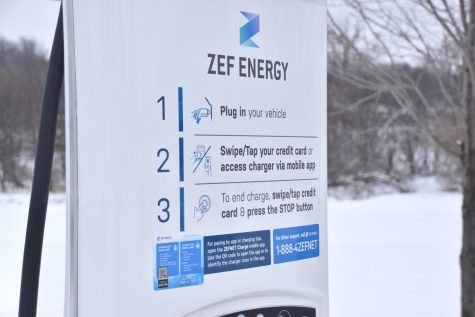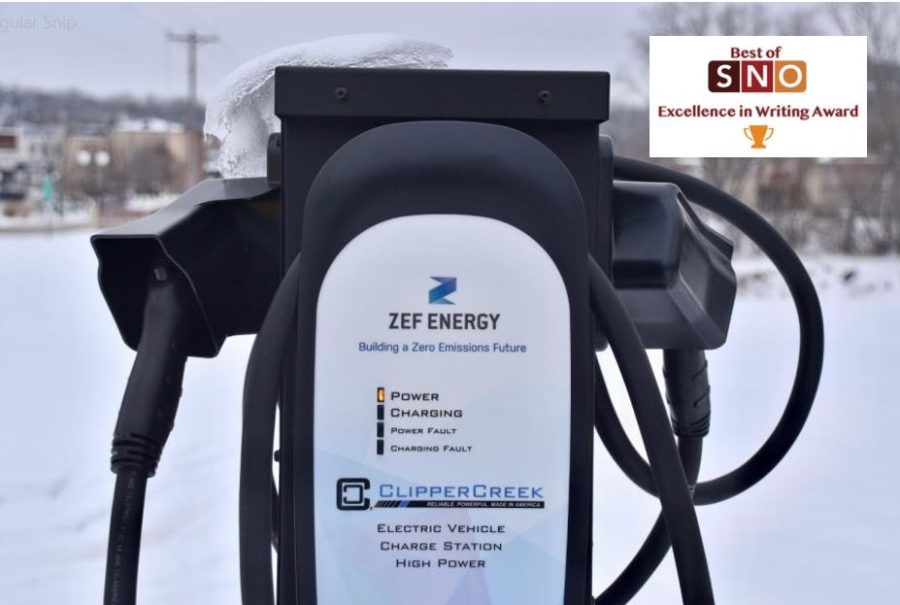EVs not ready for prime time
Despite the long term benefit of electric vehicles, the infrastructure in rural United States is not really ready for them.
Cannon Falls has limited options for EV charging but there are a set of EV chargers in the city parking lot.
Back in 2013, I got to ride in my first electric vehicle: a Chevrolet Volt. Because my family’s vehicle was in the shop for unfortunate repairs, we were loaned this hybrid in its stead. On the ride home with my father, I was fascinated by how quick and silent the car was. Electric vehicles were completely foreign to me. As I admired the sleek design and novel features, it truly felt as if the future was in my hands. Today electric cars have transitioned out of the “idea stage” and are gradually becoming a reality as their acceptance has spread throughout the country. However, rural communities are simply not ready to adopt the flurry of electric vehicles as the infrastructure and technologies needed for such vehicles are not widespread enough to suitably fit the living needs of those in rural America. Recent government bills have made it clear that the adoption of electric vehicles is a necessary action against pollution, but they cannot be imposed until everyone has proper access to these rechargeable automobiles.
One of the biggest issues associated with electric vehicles is that their batteries are not large enough to hold a charge for a substantial amount of time, and the US Department of Energy has stated that the battery packs do not perform well in cold environments or other cases necessitating rigorous use. Rural Americans travel long distances to reach their desired destinations, so in certain cases, a full charge will not safely chauffeur them to the target location.
Sara Auger, a junior at CFHS, explains that the range on her parent’s BMW i3 is not sufficient enough to take out of town: “The biggest flaw with our electric car is its inability to drive long distances. Since we live in the country, about an hour away from the two closest major cities, the car is really only good for the short trip into town and back; that make up most of our driving habits.”
Furthermore, rural driving contains more highways than that of most urban trips but according to the US Department of Energy, the efficiency of electric vehicles isn’t intended for highway use due to wind resistance. In the city, EVs take advantage of traffic and frequent stops, two aspects of city driving that many rural communities don’t share. For city-goers, stopping and charging an electric vehicle to extend the capable range is an effective solution to the distance problem, but for rural Americans, it’s not.
Gas stations are embedded throughout the United States, providing drivers with many opportunities to continue their journey. The rural portion of the US, though, severely lacks these charging stations. According to the Environmental and Energy Study Institute, urban areas contain “500 to 1000 public outlets per 25 square miles, while most suburban areas have one to 25 outlets and the majority of rural areas and small towns have none.” People cannot drive as far if they do not have charging stations near their area and it can be extremely inconvenient to charter to urban areas for a quick charge. On top of that, EV stations take significantly longer to fully charge an electric vehicle than a gas pump would take to fill a traditional vehicle. This is an extreme inconvenience for rural EV owners and when it comes to maintaining their vehicles it becomes even more of a hassle.
Chevrolet and the Ford Motor Company both have extensive networks of dealerships throughout the United States making repairs and maintenance a breeze. The downside is that Chevrolet and Ford have been relatively unsuccessful with their electric car efforts whereas Tesla has been overwhelmingly successful. Tesla has a variety of dealerships in highly populated areas like California but states in the plains contain limited, or in some cases no stores. This deficiency means that when things go wrong with an individual’s electric vehicle, fixing the issue becomes more complex and time-consuming.
Most new EVs fall into the premium sedan or crossover market but many rural buyers are looking for pickup trucks as they are more capable in many use cases. In fact, the Environmental and Energy Study Institute has found that 20.1% of new car sales consist of pickup trucks, but electric trucks are still not readily available due to the size of their batteries. Thankfully companies such as Ford are deploying new models, with Ford’s recent release of their first electric F-150 as a particular highlight.

Countless EV charger infrastructure bills have been introduced that would increase the number of high-speed chargers in areas where they are desperately needed allowing many common electric car anxieties to subside. Many consumers, like CFHS teacher John Fogarty, are ready to purchase an EV in the near future but the lack of charging options has hindered their interest significantly. Fogarty expressed that “In my condominium, there are no charging stations right now. But we have begun a campaign to get stations installed in our garages. Once this happens, it will significantly influence my decision to buy an EV.”
Another option to solve range anxiety is to buy recreational at-home charging stations and have them installed professionally, but unfortunately these types of chargers don’t charge vehicles very quickly and can drastically increase a home’s energy bill. Electric cars are still a pretty new concept in general and there is still room for innovation and improvement. In recent years, ranges have increased dramatically on various models of cars, although they still don’t match traditional gas cars. Also, EV and hybrid vehicles still carry higher price tags even after government incentives which drive many consumers away from EV products.
Electric vehicles have numerous limitations, but these issues are more aimed at rural communities. Adopting electric cars as a way to combat climate change is a necessary team effort, but urban areas have a wider variety of opportunities at the moment. Thankfully, actions are being taken to maneuver around the lack of infrastructure and limitations associated with EVs, and with the natural progression of technology, EVs will inevitably become a predominant figure in the car market within the next few years.

This is Nathan Baszuro's sixth and final year on The Lantern staff. When Nathan is not stressing about schoolwork he is often watching movies with his...

Hi Everyone! My name is Lauren Ritz and I'm a senior editor-in-chief for the Lantern. When I'm not editing articles and cooking up graphics, I enjoy playing...


